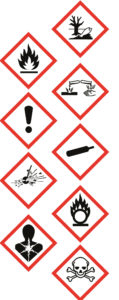Important when handling chemicals:

Copyright: Colourbox
- Read the data sheet if handling a new chemical.
- Do not put a chemical back into its original container (to avoid contamination).
- Keep the container closed.
- Flasks/bottles should not be carried by the bottleneck or close to your body – use a bucket or trolley.
- When pouring, keep the bottle turned upwards.
- Working alone? Consider the risk!
See here for work instructions If the performance of work can entail a particular risk of harm to life or health
Hazard labelling: When working with chemicals, it is important to have knowledge about the chemicals and their effects on health and the environment so that they can be used in a proper manner. The chemicals represent different hazards depending on their intrinsic properties and the extent of exposure. Check the hazard mark on the chemical and read the data sheet.
See here for an explanation of the hazard pictograms. 
Storage: All chemicals must be stored on a designated chemical room or chemical cabinet. Chemicals with the following properties are placed in their own cabinets: bases, acids, flammable, toxic and color chemicals.
Use: When using a new chemical, you must familiarize yourself with its properties, exposure including proper use, first aid and waste disposal.
Everyone who is going to work at the laboratory must get acquainted with:
-
UiB‘s electronic CHEMICAL INVENTORY, with data sheets and exposure register.
Here you will find information about the degree, safety measures, risk assessment, safety data sheet, storage, handling, disposal, training, guidelines and regulations when using chemicals.
Cytostatics and carcinogens
Hazard label: CLP H-statements H340, H350, H350i, and all H360 phrases.
Anyone working with / exposed to these substances must register the work in the exposure register.
Protective measures
Protective equipment: Consider the use of suitable protective equipment.
- Always wear gloves and lab. coat when working with chemicals.
- Goggles / protective gloves / special gloves may be required for use with certain chemicals or liquid nitrogen / dry ice.
- Wear shoes that are “sealed” over the toes to avoid injuries in the event of a spillage of chemicals.
Extractor hood: Always use hood when working with:
- Health hazardous substances (When using Cytostats and Carcinogens, Always Use LAF Bench With Ventilation).
- Malodoeous liquids.
- Solvents.
See here for work instructions If the performance of work can entail a particular risk of harm to life or health
See here for internal UoB guidelines.
See here for an explanation of the hazard pictograms.